Vision, Mission and Quality Objectives
Department of Electrical Power Engineering produces the essential skillful electrical engineers to develop our country.
- To enhance the quality and self-confident engineers from Department of Electrical Power Engineering, Technological University (Toungoo).
- To fulfill the engineers from Department of Electrical Power Engineering, Technological University (Toungoo) into the workplace.
- To make an effort to get customer feedback by 80% in 2023-2024 academic year.
- In the 2023-2024 academic year, in order to develop the quality of the teachers/teachers serving in the Department of Electrical Power Engineering, to deliver at least three (3) quality improvement courses per academic year.
Organization Chart of Electrical Power Engineering Department
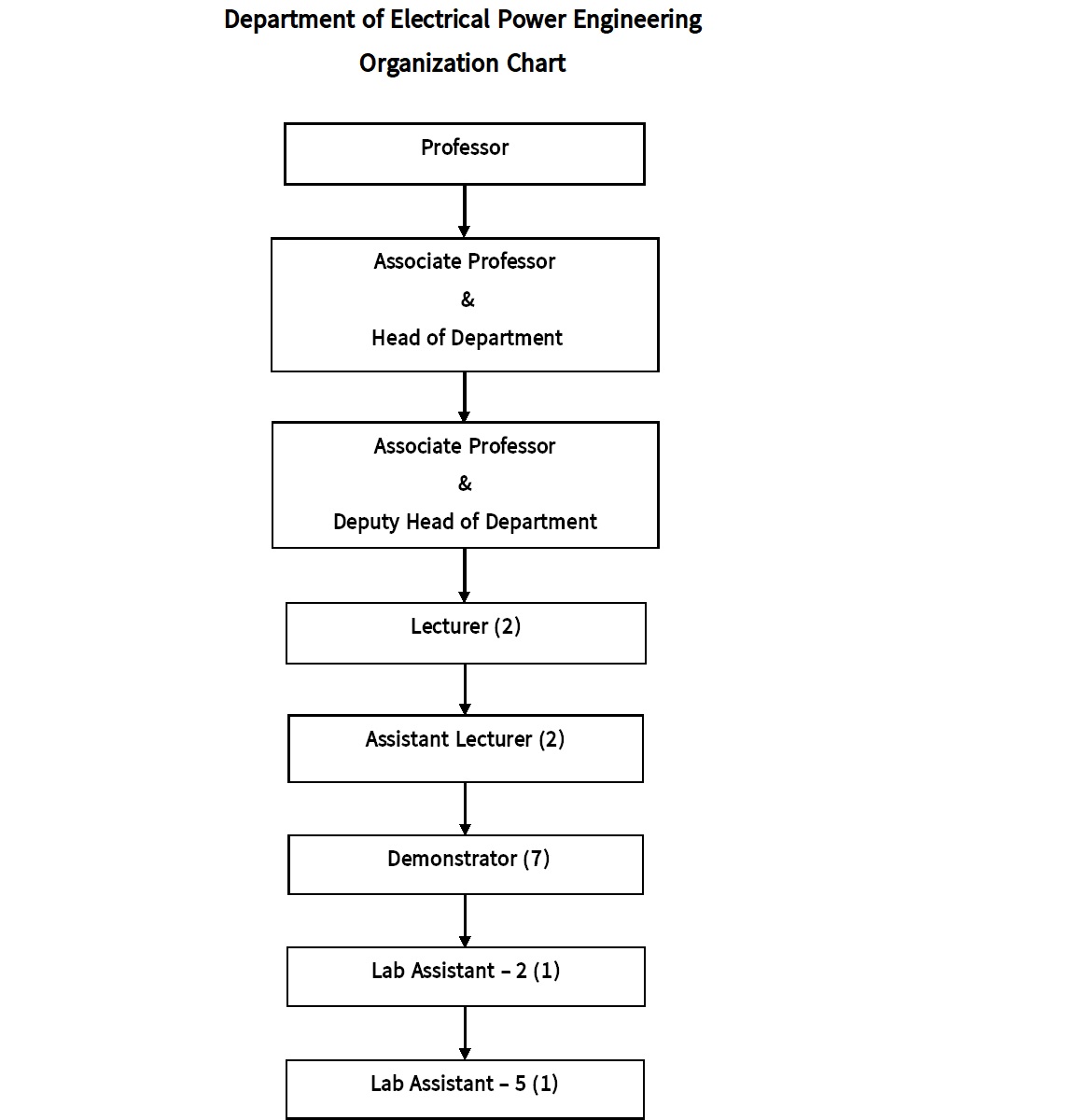
Curriculum
FIRST YEAR (First Semester)
Sr. No | Code | Course | Periods/Week | Credit Points | |||
Lect. | Tut. | Pract. | Total | ||||
1 | M – 11011 | Myanmar | 2 | 0 | 0 | 2 | 2 |
2 | E – 11011 | English | 2 | 1 | 0 | 3 | 2.5 |
3 | EM– 11001 | Engineering Mathematics I | 4 | 1 | 0 | 5 | 4.5 |
4 | E.Ch. – 11011 | Engineering Chemistry | 3 | 1 | 2 | 6 | 4.5 |
5 | E.Ph. – 11011 | Engineering Physics | 2 | 1 | 2 | 5 | 3.5 |
6 | ME – 11011 | Basic Engineering Drawing | 1 | 0 | 2 | 3 | 2 |
7 | EP-11011 | Principle of Electrical Engineering I | 2 | 0 | 1 | 3 | 2.5 |
Total | 16 | 4 | 7 | 26 | 21.5 | ||
FIRST YEAR (Second Semester)
Sr. No | Code | Course | Periods/Week | Credit Points | |||
Lect. | Tut. | Pract. | Total | ||||
1 | M – 12011 | Myanmar | 2 | 0 | 0 | 2 | 2 |
2 | E – 12011 | English | 2 | 1 | 0 | 3 | 2.5 |
3 | EM– 12002 | Engineering Mathematics II | 4 | 1 | 0 | 5 | 4.5 |
4 | E.Ch. – 12011 | Engineering Chemistry | 3 | 1 | 2 | 6 | 4.5 |
5 | E.Ph. – 12011 | Engineering Physics | 2 | 1 | 2 | 5 | 3.5 |
6 | ME – 12011 | Basic Engineering Drawing | 1 | 0 | 2 | 3 | 2 |
7 | EP-12011 | Principle of Electrical Engineering II | 2 | 0 | 1 | 3 | 2.5 |
Total | 16 | 4 | 7 | 26 | 21.5 | ||
SECOND YEAR (First Semester)
Sr. No | Code | Course | Periods/Week | Credit Points | |||
Lect. | Tut. | Pract. | Total | ||||
1 | E -21011 | English | 2 | 1 | 0 | 3 | 2.5 |
2 | EM-21003 | Engineering Mathematics III | 4 | 1 | 0 | 5 | 4.5 |
3 | EP-21011 | Electrical Engineering Circuit Analysis I | 2 | 0 | 1 | 3 | 2.5 |
4 | EP-21014 | Basic Electronics I | 2 | 0 | 1 | 3 | 2.5 |
5 | EP-21021 | Electromechanics I | 2 | 0 | 1 | 3 | 2.5 |
6 | EP-21026 | Generation, Transmission and Distribution I | 2 | 1 | 0 | 3 | 2.5 |
7 | ME-21015 | Engineering Mechanics I | 2 | 1 | 0 | 3 | 2.5 |
Total | 16 | 4 | 3 | 23 | 19.5 | ||
SECOND YEAR (Second Semester)
Sr. No | Code | Course | Periods/Week | Credit Points | |||
Lect. | Tut. | Pract. | Total | ||||
1 | E-22011 | English | 2 | 1 | 0 | 3 | 2.5 |
2 | EM-22004 | Engineering Mathematics IV | 4 | 1 | 0 | 5 | 4.5 |
3 | EP-22011 | Electrical Engineering Circuit Analysis II | 2 | 0 | 1 | 3 | 2.5 |
4 | EP-22014 | Basic Electronics II | 2 | 0 | 1 | 3 | 2.5 |
5 | EP-22021 | Electromechanics II | 2 | 0 | 1 | 3 | 2.5 |
6 | EP-22026 | Generation, Transmission and Distribution II | 2 | 1 | 0 | 3 | 2.5 |
7 | ME-22015 | Engineering Mechanics II | 2 | 1 | 0 | 3 | 2.5 |
Total | 16 | 4 | 3 | 23 | 19.5 | ||
THIRD YEAR (First Semester)
Sr.No | Code No. | Courses | Periods/ Week | Credit Points | |||
Lect | Tut | Pract | Total | ||||
1 | E 31011 | English | 2 | 1 | 0 | 3 | 2.5 |
2 | EM 31005 | Engineering Mathematics V | 4 | 1 | 0 | 5 | 4.5 |
3 | ME 31034 | Mechanical Engineering Fundamentals | 2 | 1 | 0 | 3 | 2.5 |
4 | EP 31011 | Electrical Engineering Circuit Analysis III | 2 | 0 | 1 | 3 | 2.5 |
5 | EP 31014 | Power Electronics I | 2 | 0 | 1 | 3 | 2.5 |
6 | EP 31021 | Electrical Machine and Operation I | 2 | 0 | 1 | 3 | 2.5 |
7 | EP 31033 | Electromagnetic Field I | 2 | 1 | 0 | 3 | 2.5 |
8 | EP 31025 | Electrical Measurement and Instrumentation | 2 | 0 | 1 | 3 | 2.5 |
Total | 18 | 4 | 4 | 26 | 22 | ||
THIRD YEAR (Second Semester)
Sr.No | Code No. | Courses | Periods/ Week | Credit Points | |||
Lect | Tut | Pract | Total | ||||
1 | E 32011 | English | 2 | 1 | 0 | 3 | 2.5 |
2 | EM 32006 | Engineering Mathematics VI | 4 | 1 | 0 | 5 | 4.5 |
3 | ME 32034 | Mechanical Engineering Fundamentals | 2 | 1 | 0 | 3 | 2.5 |
4 | EP 32011 | Electrical Engineering Circuit Analysis IV | 2 | 0 | 1 | 3 | 2.5 |
5 | EP 32014 | Power Electronics II | 2 | 0 | 1 | 3 | 2.5 |
6 | EP 32021 | Electrical Machine and Operation II | 2 | 0 | 1 | 3 | 2.5 |
7 | EP 32033 | Electromagnetic Field II | 2 | 1 | 0 | 3 | 2.5 |
8 | EP 32034 | Electrical Design, Estimating and Costing | 2 | 0 | 1 | 3 | 2.5 |
Total | 18 | 4 | 4 | 26 | 22 | ||
REMARK: EP 31025 နှင့် EP 32034 (၂) ဘာသာပေါင်းအတွက် ပေးမှတ် (၁၀၀) မှတ်ဟု သတ်မှတ်သည်။
FOURTH YEAR (First Semester)
Sr.No | Code No. | Courses | Periods/ Week | Credit Points | |||
Lect | Tut | Pract | Total | ||||
1 | E 41011 | English | 2 | 1 | 0 | 3 | 2.5 |
2 | EM 41007 | Engineering Mathematics VII | 4 | 1 | 0 | 5 | 4.5 |
3 | EP 41027 | Linear Control System I | 2 | 1 | 0 | 3 | 2.5 |
4 | EP 41028 | Programmable Logic Control I | 2 | 0 | 1 | 3 | 2.5 |
5 | EP 41021 | Electrical Machine Design I | 2 | 1 | 0 | 3 | 2.5 |
6 | EP 41036 | Design and Layout of Power System I | 2 | 1 | 0 | 3 | 2.5 |
7 | EP 41042 | Power System Analysis I | 2 | 1 | 0 | 3 | 2.5 |
8 | EcE 41024 | Computer Science I | 2 | 0 | 1 | 3 | 2.5 |
Total | 18 | 6 | 2 | 26 | 22 | ||
FOURTH YEAR (Second Semester)
Sr.No | Code No. | Courses | Periods/ Week | Credit Points | |||
Lect | Tut | Pract | Total | ||||
1 | E 42011 | English | 2 | 1 | 0 | 3 | 2.5 |
2 | EM 42007 | Engineering Mathematics VIII | 4 | 1 | 0 | 5 | 4.5 |
3 | EP 42027 | Linear Control System II | 2 | 1 | 0 | 3 | 2.5 |
4 | EP 42028 | Programmable Logic Control II | 2 | 0 | 1 | 3 | 2.5 |
5 | EP 42021 | Electrical Machine Design II | 2 | 1 | 0 | 3 | 2.5 |
6 | EP 42036 | Design and Layout of Power System II | 2 | 1 | 0 | 3 | 2.5 |
7 | EP 42042 | Power System Analysis II | 2 | 1 | 0 | 3 | 2.5 |
8 | EcE 42024 | Computer Science II | 2 | 0 | 1 | 3 | 2.5 |
Total | 18 | 6 | 2 | 26 | 22 | ||
FIFTH YEAR (First Semester)
Sr.No | Code No. | Courses | Periods/ Week | Credit Points | |||
Lect | Tut | Pract | Total | ||||
1 | EP 51017 | Modern Control System I | 2 | 1 | 0 | 3 | 2.5 |
2 | EP 51014 | Electrical Machine and Control I | 2 | 0 | 1 | 3 | 2.5 |
3 | EP 51022 | Power System Protection I | 2 | 1 | 0 | 3 | 2.5 |
4 | EP 51002 | Power System Stability | 2 | 1 | 0 | 3 | 2.5 |
5 | EP 51043 | Electromechanical Energy Conversion I | 2 | 1 | 0 | 3 | 2.5 |
Total | 10 | 4 | 1 | 15 | 12.5 | ||
FIFTH YEAR (Second Semester)
Sr.No | Code No. | Courses | Periods/ Week | Credit Points | |||
Lect | Tut | Pract | Total | ||||
1 | EP 52017 | Modern Control System II | 2 | 1 | 0 | 3 | 2.5 |
2 | EP 52014 | Electrical Machine and Control II | 2 | 0 | 1 | 3 | 2.5 |
3 | EP 52022 | Power System Protection II | 2 | 1 | 0 | 3 | 2.5 |
4 | EP 52002 | Economic Operation of Power System | 2 | 1 | 0 | 3 | 2.5 |
5 | EP 52043 | Electromechanical Energy Conversion II | 2 | 1 | 0 | 3 | 2.5 |
6 | EP 52007 | Integrated Designed Project (IDP) | – | – | – | – | 3 |
Total | 10 | 4 | 1 | 15 | 15.5 | ||
REMARK:
(1) EP-51002 နှင့် EP-52012 (၂) ဘာသာပေါင်း အတွက် ပေးမှတ် (၁၀၀) မှတ်ဟု သတ်မှတ်သည်။
(2) EP 52007 အတွက် အောင်ရှုံးသတ်မှတ်ချက်သည် IDP လုပ်ဆောင်ချက်ပြီး/မပြီး ဖြင့်သာ သတ်မှတ်သည်။
SIXTH YEAR (First Semester)
Sr.No | Code No. | Courses | Periods/ Week | Credit Points | |||
Lect | Tut | Pract | Total | ||||
1 | HSS 61011 | Humanities and Social Science | 4 | 0 | 0 | 4 | 4 |
2 | EP 61033 | Computer Aided Electrical Engineering | 1 | 0 | 1 | 2 | 1.5 |
3 | EP 61014 | Electrical Safety and Ethic | 1 | 0 | 0 | 1 | 1 |
4 | EP 61012 | Power System Reliability | 1 | 0 | 0 | 1 | 1 |
Total | 8 | 1 | 1 | 10 | 7.5 | ||
SIXTH YEAR (Second Semester)
Sr.No | Code No. | Courses | Periods/ Week | Credit Points | |||
Lect | Tut | Pract | Total | ||||
1 | EP 62005 | Industrial Training/Internship Program | – | – | – | – | 4 |
2 | EP 62015 | Mini Thesis/Final Year Project | – | – | – | – | 9 |
Total | – | – | – | – | 13 | ||
Lab and Activities
|
Sr. No |
Programme Name |
Fields |
Respective Labs |
Class |
|
1. |
Electrical Engineering |
1. Power System Engineering |
1. Electricity & Electronics Fundamental Trainer |
-1st Year -2nd Year |
|
2. Industrial Electronics Trainer |
-2nd Year -3rd Year |
|||
|
3. Digital Trainer & Electronics Trainer |
-2nd Year -3rd Year |
|||
|
4. Power Transmission & Smart Grid Trainer |
-2nd Year -3rd Year -4th Year |
|||
|
5. Electrical Installation (Basic) |
-1st Year -2nd Year |
|||
|
6. Electrical Installation (Domestic Wiring) |
-2nd Year -3rd Year |
|||
|
7. Electrical Transmission & Distribution Training |
-2nd Year -3rd Year -4th Year |
|||
|
2. Power Electronics & Control |
1. Festo Labvolt Series Trainer |
-3rd Year -4th Year -5th Year |
||
|
2. COM3 Lab Trainer |
-3rd Year -5th Year |
|||
|
3. Electrical Machine & Control Lab |
1. Single-Phase & Three-Phase Transformer Training System |
-2nd Year -3rd Year |
||
|
2. Electrical Machine Trainer |
-2nd Year -3rd Year |
|||
|
3. Induction Machine Training System |
-3rd Year -4th Year |
|||
|
4. Electric Technology Training Equipment with Transformer Training |
-3rd Year -4th Year |
|||
|
5. Motor & Towage Trainer |
-3rd Year -4th Year |
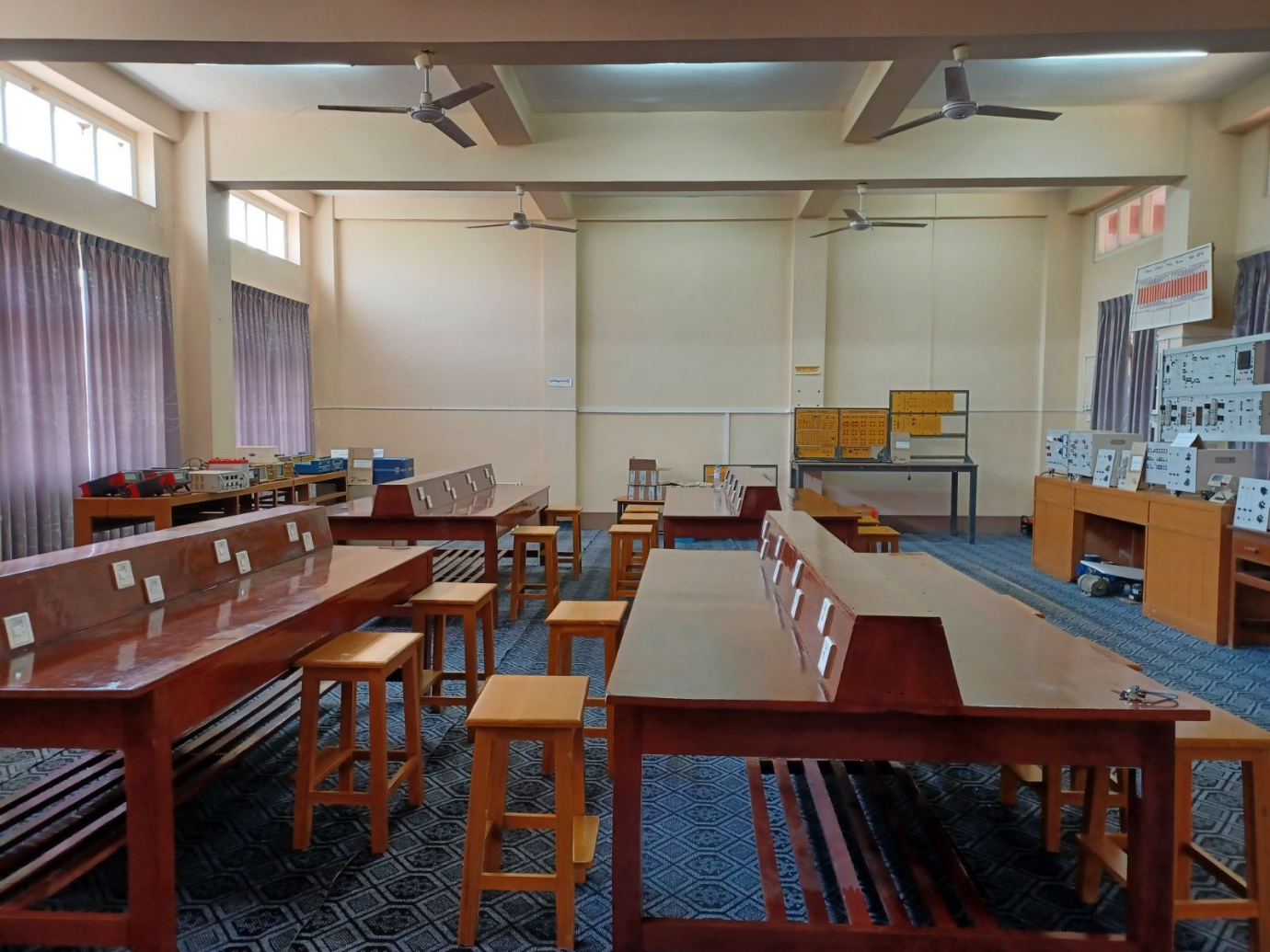
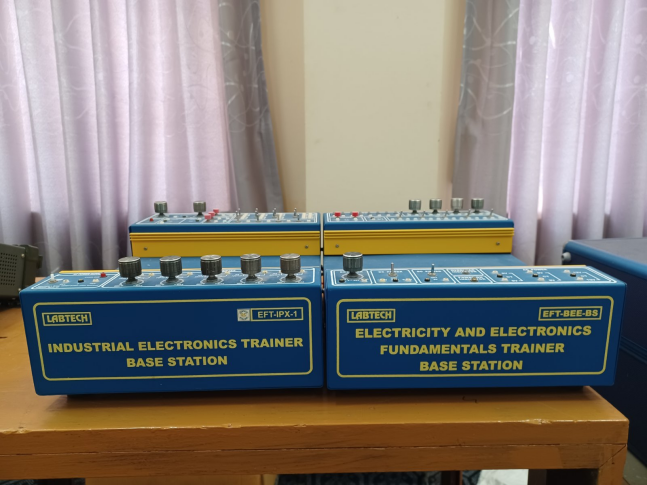
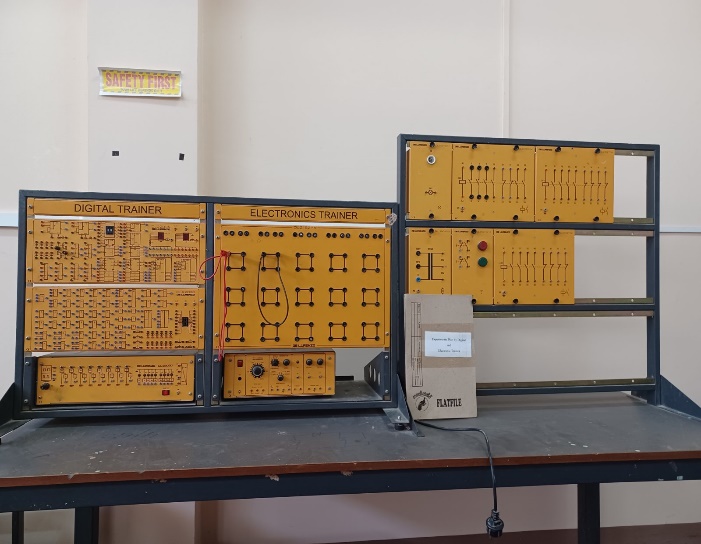
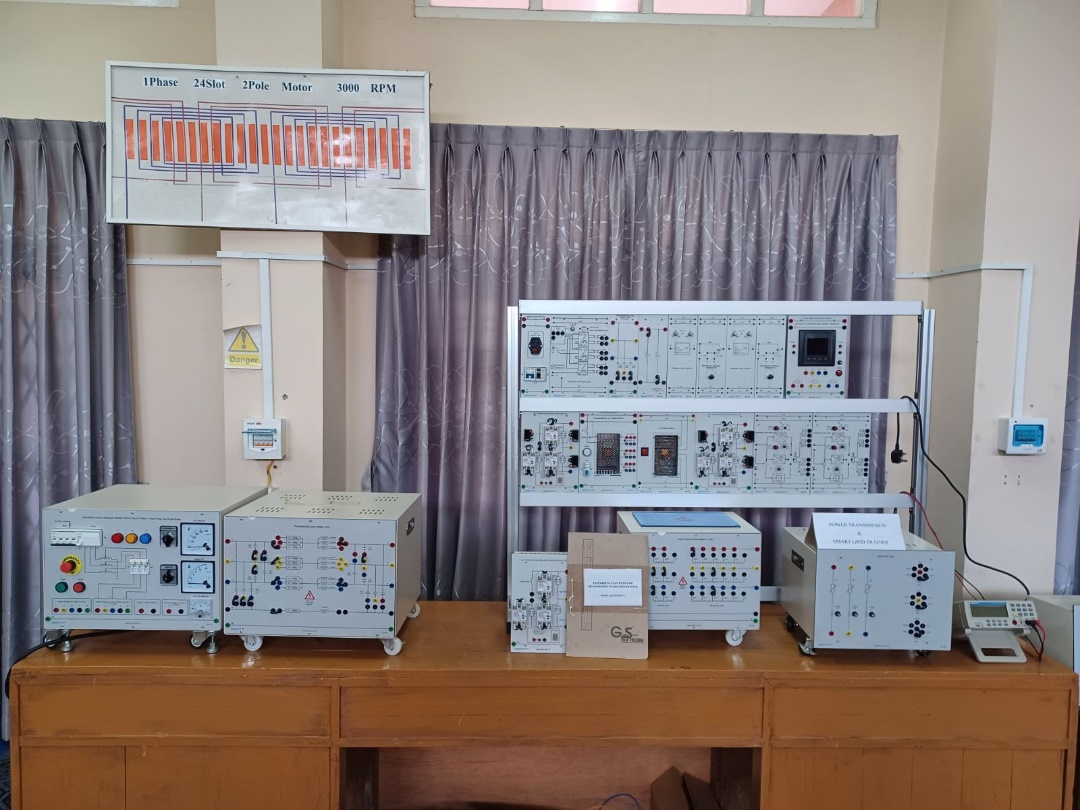
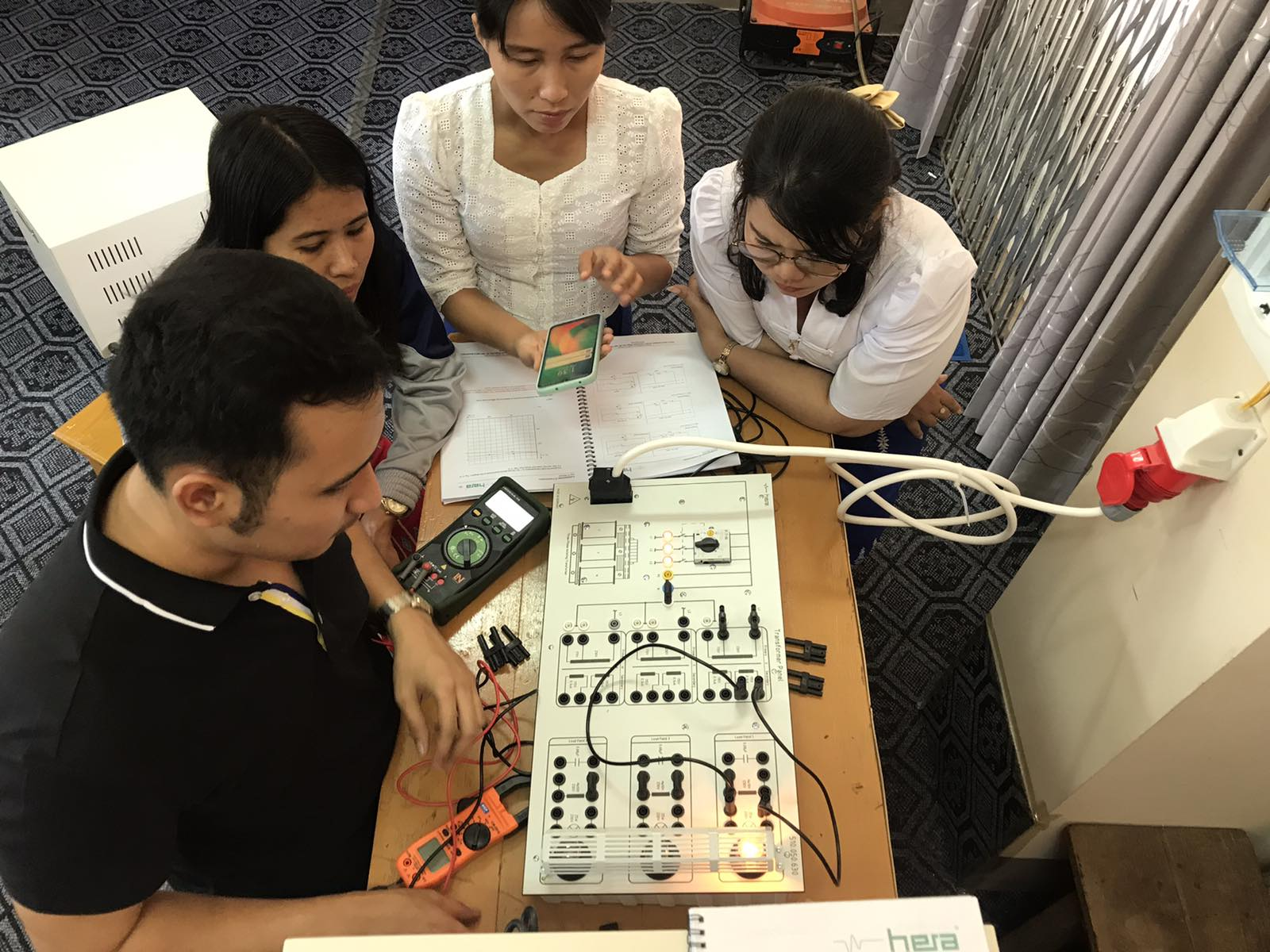
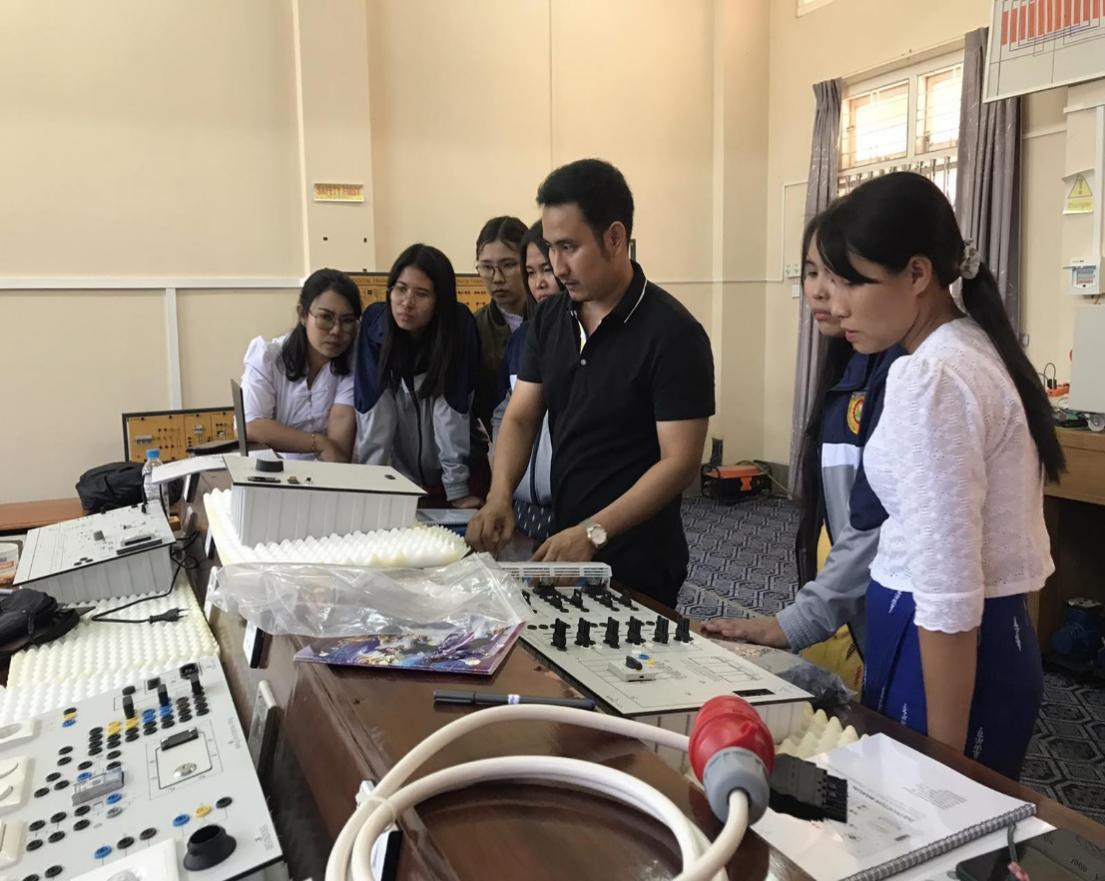

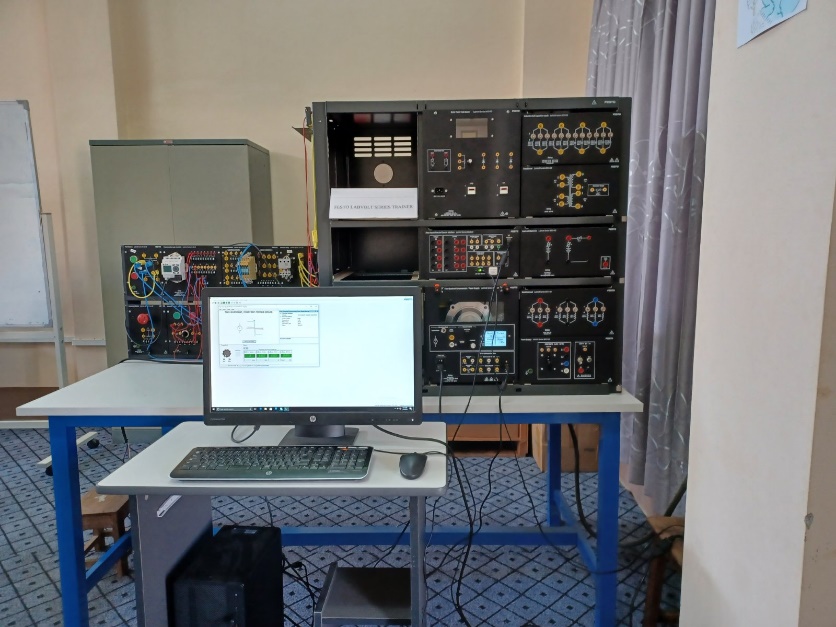
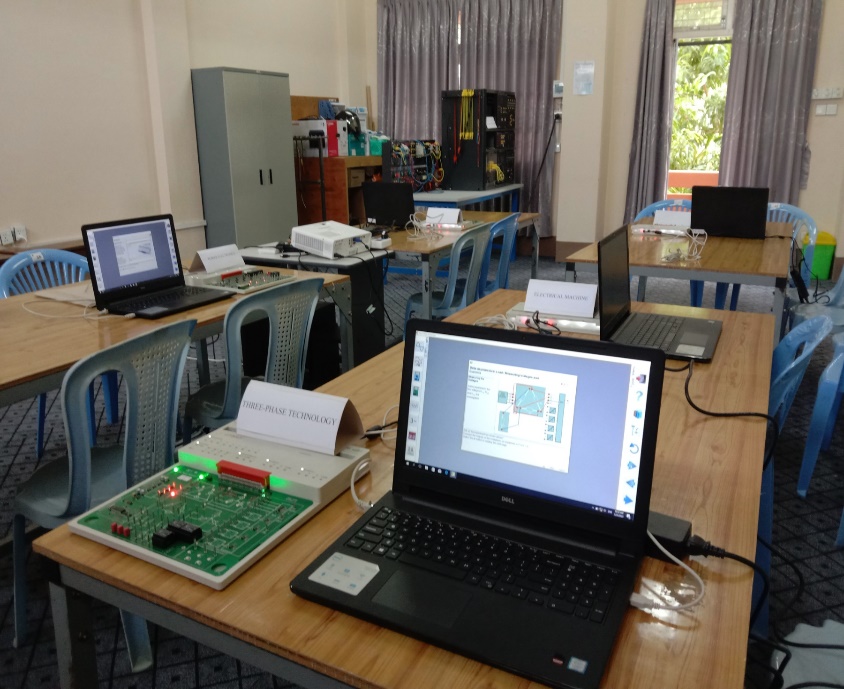
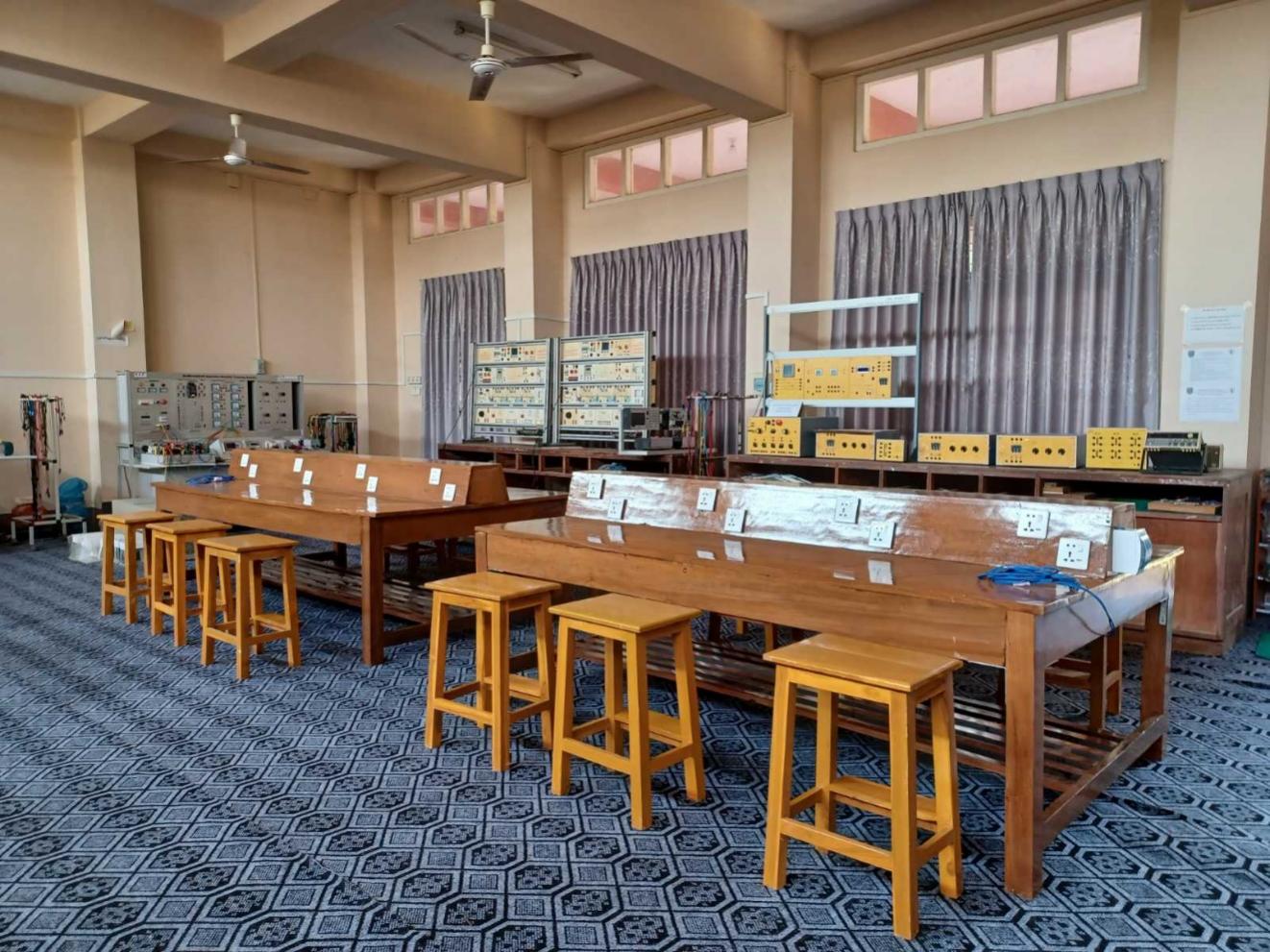
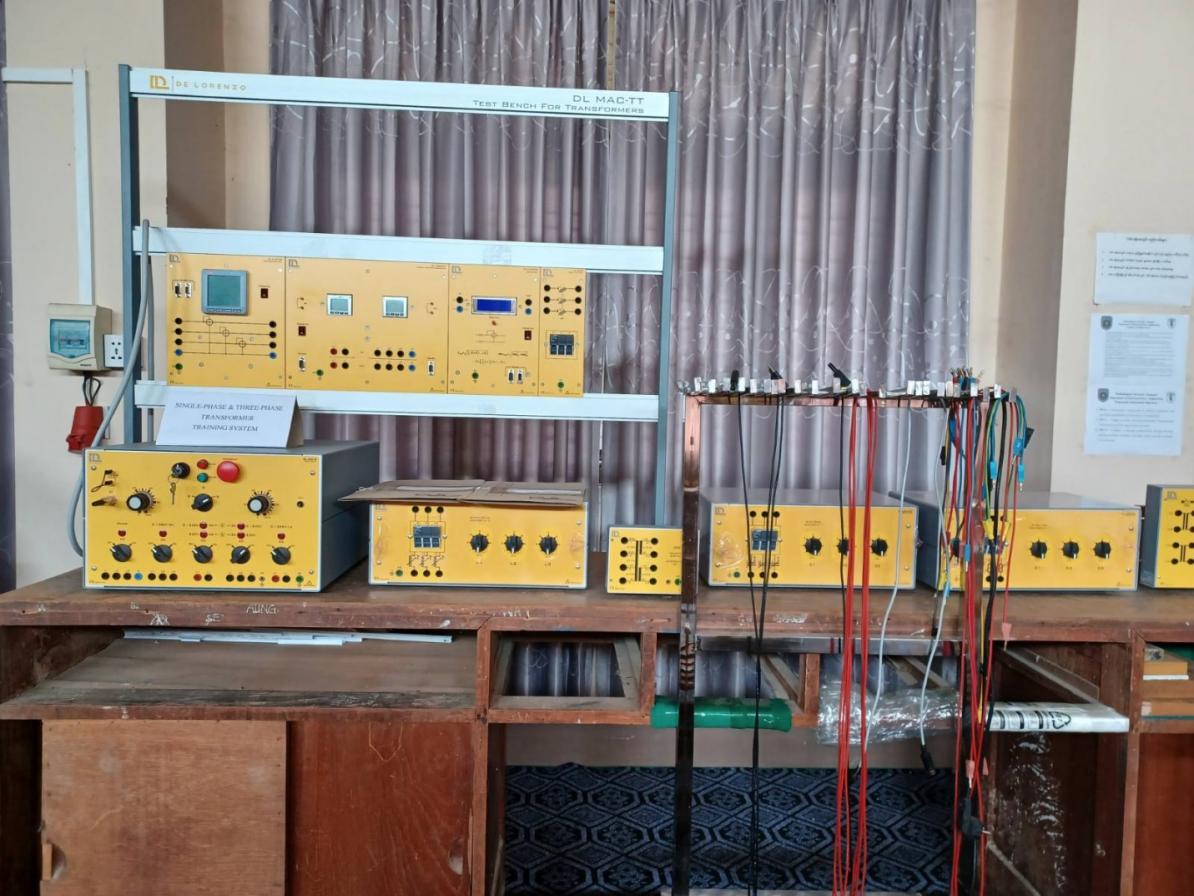
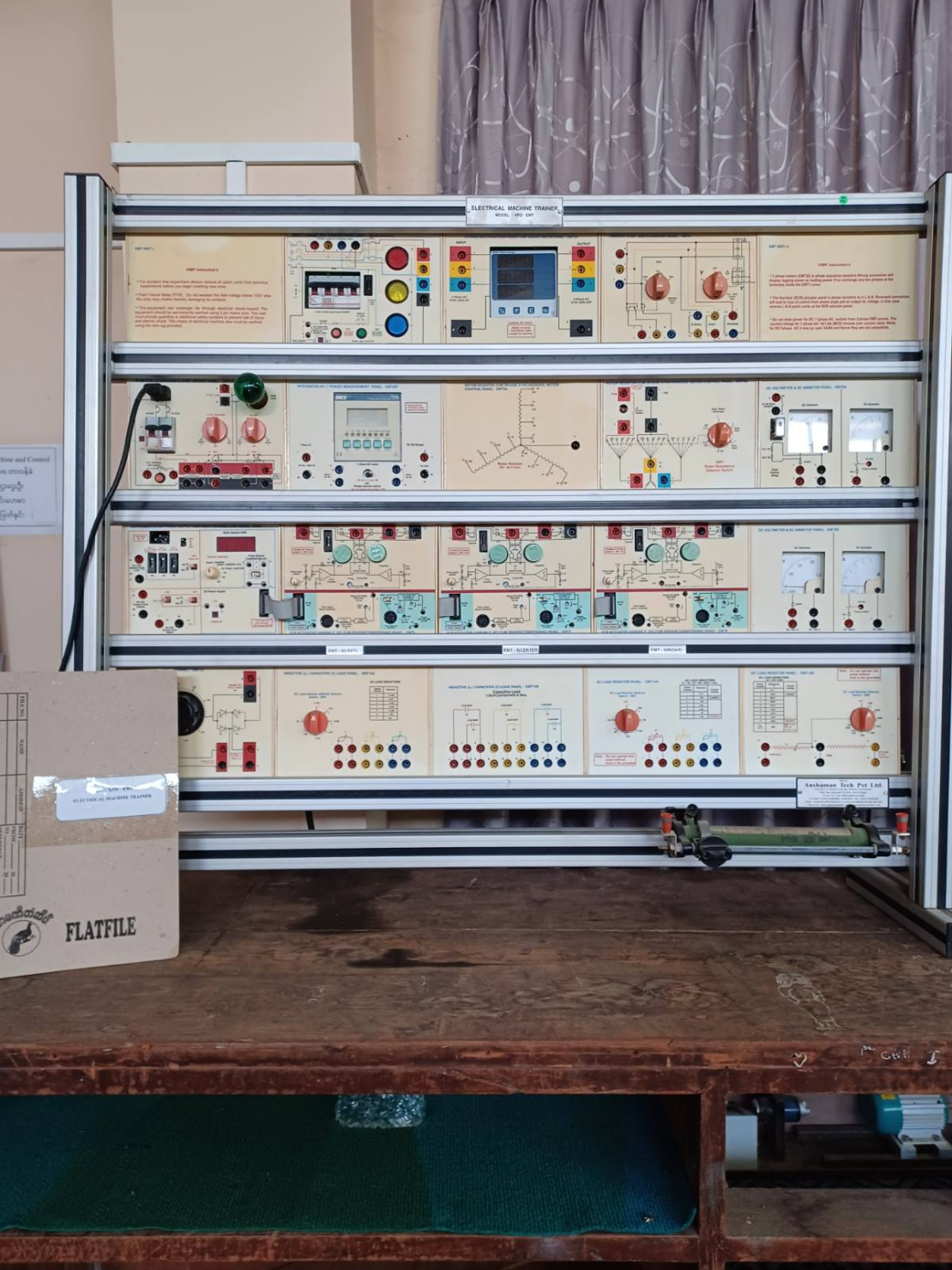
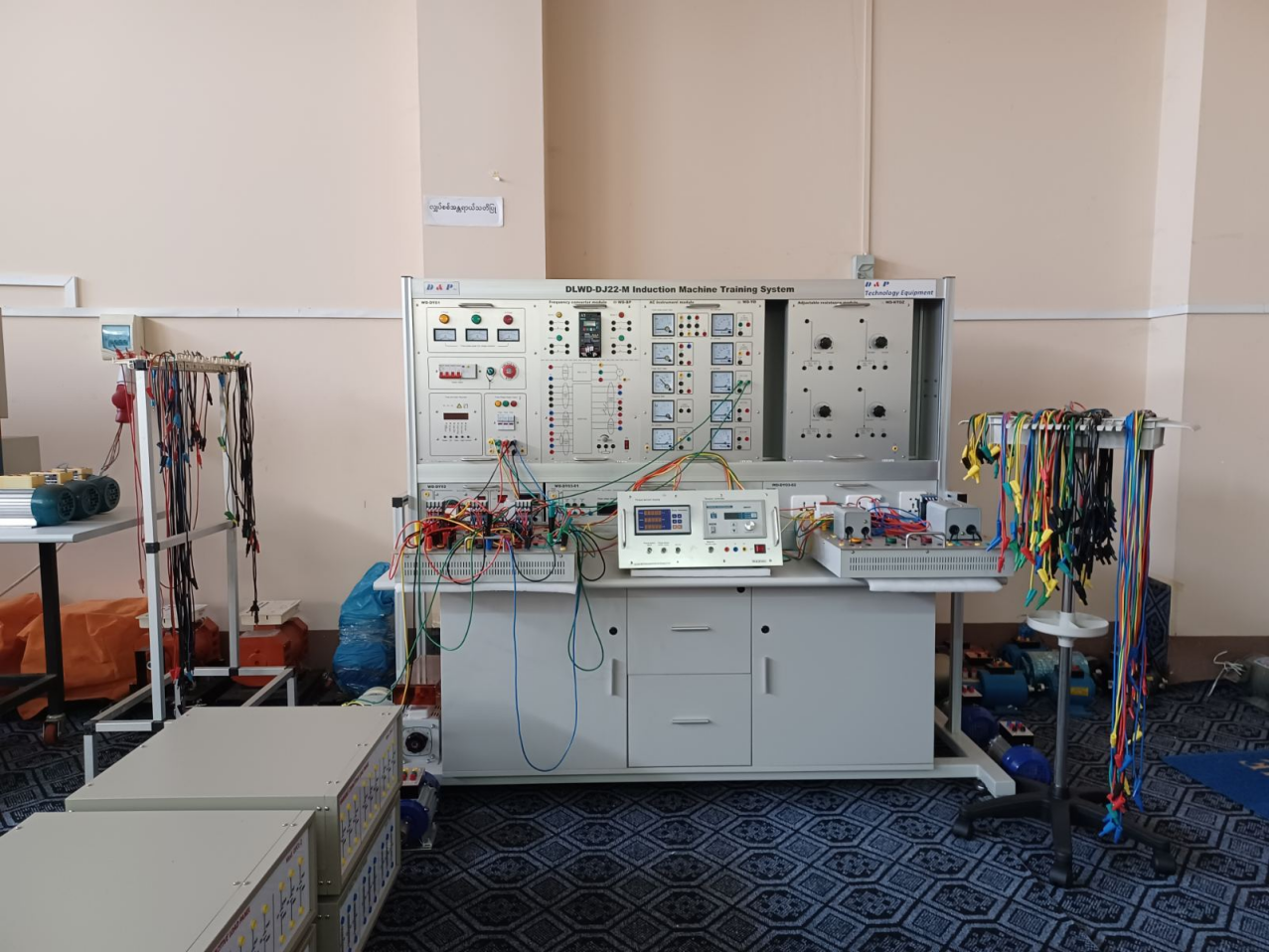
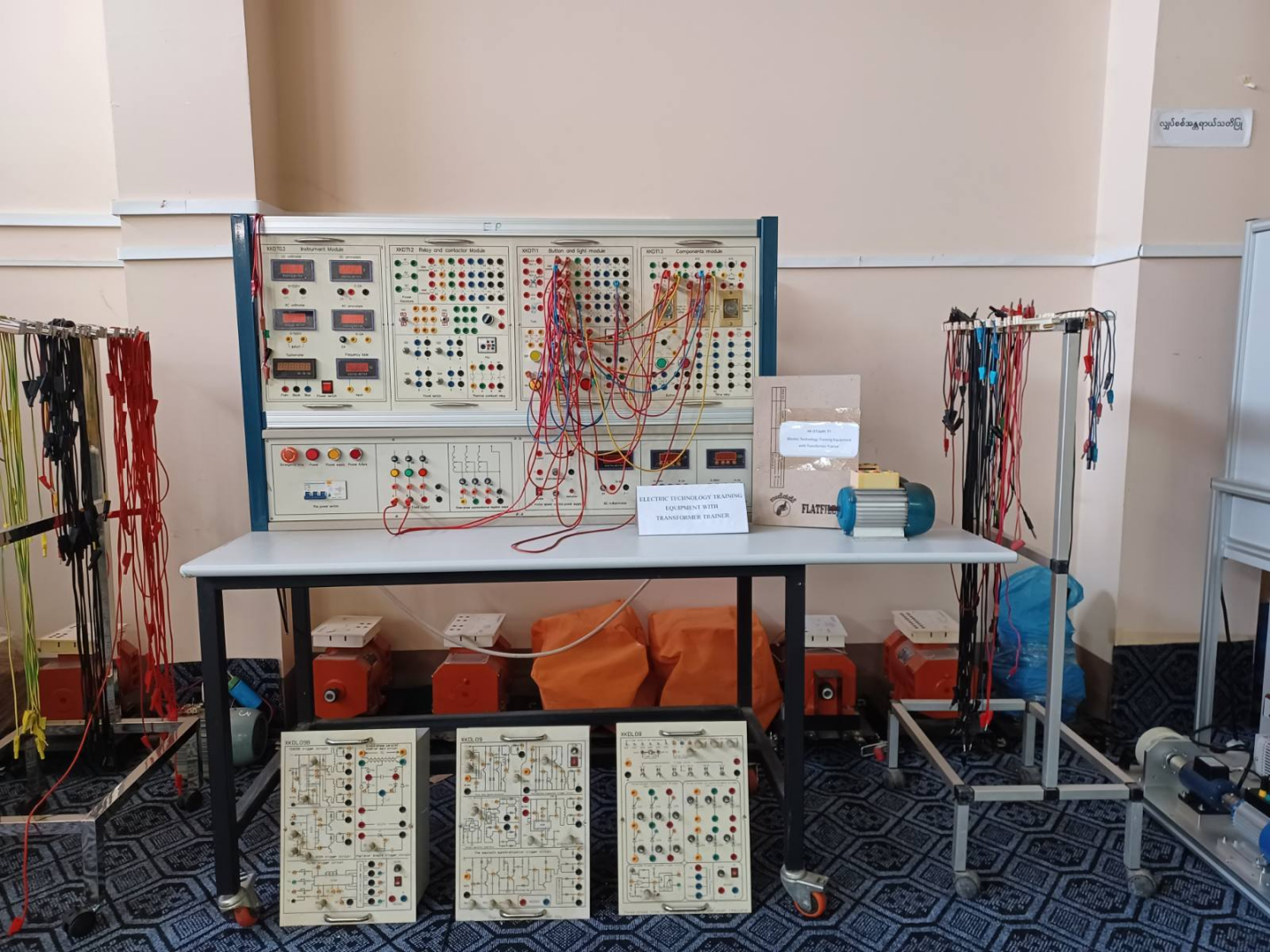
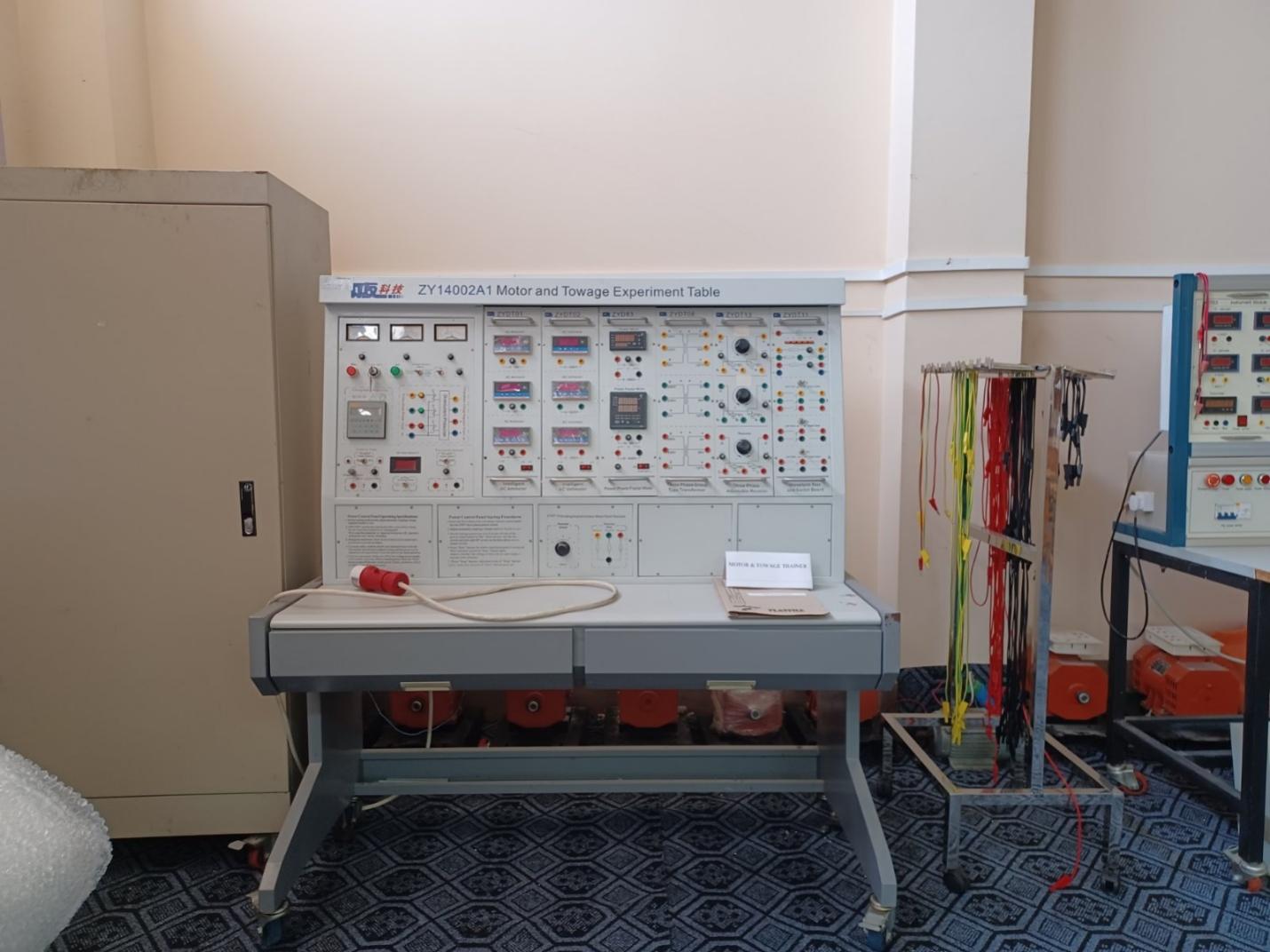
Technological University (Toungoo)
Department of Electrical Power Engineering
Undergratuaded Programme
Vision of the University
To become an internationally recognized University that nurtures brilliant engineers who apply best practices in engineering education, research and knowledge and help the community
Mission of the University
In order to create excellent academic environment for all- around development of community, Technological University (Toungoo) will carry out the following actions as its responsibilities.
– To train students systematically to become skilled engineers and researchers who innovate well in the community in accordance with ethics
– To train students in order to emerge brilliant engineers who keep pace with current leadership qualities and accept the realistic view
– To become the active and alert persons with continual learning in their respective fields.
Programme Learning Outcomes (PLOs)
After completing the programme, students will be able to:
PLO 1 – Apply knowledge of mathematics, science, and engineering principles to solve complex electrical power engineering problems.
PLO 2 – Analyze complex engineering problems by identifying, formulating, and deriving conclusions using scientific and engineering principles.
PLO 3 – Design innovative solutions for complex electrical power systems considering public health, safety, cultural, societal, and environmental factors.
PLO 4 – Investigate complex problems in electrical power engineering using research-based knowledge and methods, including data analysis and interpretation.
PLO 5 – Utilize modern engineering tools, techniques, and software to solve electrical power engineering problems while understanding their limitations.
PLO 6 – Assess societal, health, safety, and legal responsibilities relevant to professional engineering practice.
PLO 7 – Demonstrate an understanding of environmental sustainability and the impact of professional engineering solutions in global and societal contexts.
PLO 8 – Commit to ethical principles and professional responsibilities in engineering practice while engaging in lifelong learning to address emerging challenges.
Mapping Graduate Attributes to PLOs
| Graduate Attributes | Progamme Learning Outcomes (PLOs) |
1 | Engineering Knowledge | PLO 1 |
2 | Problem Analysis | PLO 2 |
3 | Design/ Development of Solutions | PLO 3 |
4 | Investigation | PLO 4 |
5 | Modern Tool Usage | PLO 5 |
6 | The Engineer and Society | PLO 6 |
7 | Environment and Sustainability | PLO 7 |
8 | Ethics | PLO 8 |
9 | Individual and Team Work | |
10 | Communication | |
11 | Project Management and Finance | |
12 | Life-long Learning |
